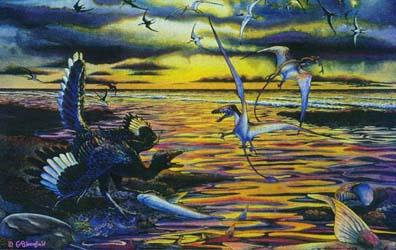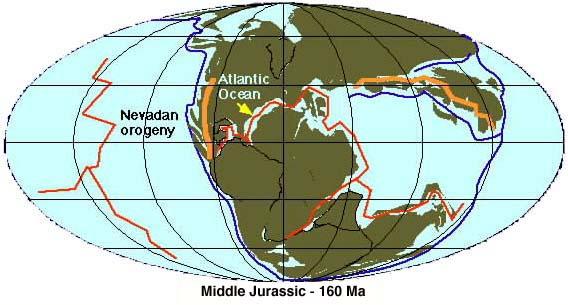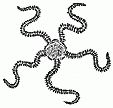
Post storm cleanup
Gary Bloomfield
A violent storm has left a wealth of sea life strewn over a coral reef in what is now the Solnhoven limestone formation. Several species of pterosaurs (Pterodactylus, Rhamphorhynchus, and Germanodactylus) circle overhead. An Archaeopteryx has flown out and is defending the carcass of a small shark from a pair of small pterosaurs (Scaphognathus). Use of this image is protected by copyright.
199.6-145.5 Million years ago
Richard Paselk
Plate Tectonic Reconstructions

These maps of major tectonic elements (plates, oceans, ridges, subduction zones, mountain belts) are used with permission from Dr. Ron Blakey at Northern Arizona University. The positions of mid-ocean ridges before 200 Ma are speculative. Explanation of map symbols.
Jurassic* ammonites and dinosaurs made a huge comeback after their near extinction at the end of the Triassic. Oysters, crabs, lobsters, and teleost (modern) fish appear. Plesiosaurs and marine crocodiles first appeared, joining icthyosaurs, sharks, bony fish, cephalopods and many other marine predators. Reef ecosystems built on coral and sponge backbones flourished, providing homes for gastropods and the remaining lower numbers of the declining members of the Paleozoic fauna such as brachiopods and sea lilies. Reptiles remain the dominant land animals even after their massive losses to extinction at the end of the Triassic. Dinosaurs grow larger, with the largest saurichians appearing in the Upper Jurassic. The other main dinosaur group, the ornithicians, makes their first appearance in the Jurassic. The first birds show up in the fossil record, but flying pterosaurs of all sizes rule the air. Theropod dinosaurs, which gave rise to birds, continue to evolve in parallel—both groups are covered in colorful feathers. Insect diversify, evolving many modern forms such as wasps and beetles. The first lizards appear, probably feeding on the new insect diversity. Conifers dominate coal-producing forests. Forests covered much of the land, with trees such as conifers, gingko, and an under story of plants such as ferns, cycads and horsetail rushes. Flowering plants had yet to evolve and there were no grasses so the open plains of modern Earth did not exist making it a very different world than today.
The supercontinent Pangaea begins breaking up during the Jurassic, with the birth of the Central Atlantic Ocean at the end of the Middle Jurassic. Sea levels start low, becoming high by the Middle Jurassic. Most of today's continental outlines are delineated by the end of the Jurassic, though they are not in their current locations. Pangea and what became North America, was located equatorially for most of the Jurassic. Earth experienced a warm, moist greenhouse climate, especially in the late Jurassic, when much of the world was lush and tropical. Deposits rich in organic materials are sources for today’s petroleum, while coal beds were formed in Australia and Antarctica.
*Jurassic derives from Alexander von Humboldt's use of the term “Jura Kalstein” for carbonate deposits in the Jura region of Switzerland in 1799.
Jurassic Animal (Metazoan) Fossils
Crustacea (ToL: Arthropoda<Ecdysozoa<Bilateria<Metazoa<Eukaryota)

Crustaceans
Although the trilobites had vanished in the Permian extinction event, the arthopods were well represented in the oceans by crustaceans. These included shrimp, lobsters, and crabs such as Eryon.
Echinoderms (ToL: Echinodermata<Deuterostomia<Bilateria<Metazoa<Eukaryota)

Brittle stars
Brittle stars (Ophiuroidea) are represented by specimens of Geocoma elegans on a rock slab.

Sea urchins
Sea urchins (Echinoidea) diversified during the Jurassic. Cidaris coronata is an example.
Fish (ToL: Vertebrata<Chordata<Deuterostomia<Bilateria<Metazoa<Eukaryota)

Ray-finned fish
Ray-finned fish (Actinopterigii), such as Leptolepis sprattiformis, diversified beginning in the middle of the Mesozoic, and have continued to diversify up to the present. Leptolepis was one of the first teleost fish, and was the first "bony" fish to have a complete sketeton of bone rather than cartilage. It also had modern scales.
![]() Leptolepis sprattiformis
Leptolepis sprattiformis  life reconstruction of Leptolepis school
life reconstruction of Leptolepis school
Reptilia (ToL: Vertebrata<Chordata<Deuterostomia<Bilateria<Metazoa<Eukaryota)

Dinosaurs
Dinosaurs (Dinosauria [Birds and Dinosaurs]<Reptilia)
Of the two major dinosaur groups, the ornithicians are represented by a skull cast (a Hypsilophodont Othniella rex also known as “Nannosaurus rex”).
![]() Othniella rex
Othniella rex![]() life reconstruction
life reconstruction
The sauricians (Sauropoda) are represented by a museum-quality model of an adult and juvenile Mamenchisaurus on top of the case. This dinosaur had the longest neck (about 41 ft) of known dinosaurs, to give a animal with a total length of 70–80 ft. The long neck of these animals was probably held nearly horizontal rather than vertically like a giraffe since the immense length would not allow the heart to produce enough pressure to get blood to the brain in a vertical position. So why the long neck then? Possibly the long neck allowed these dinosaurs to reach between trees in dense forest where their immense size would block them, or out onto swamps while the animal stood on the firm shore.
![]() Mamenchisaurus adult and juvenile model
Mamenchisaurus adult and juvenile model
The other dinosaur fossils may be of either ornithician or saurichian origin:
![]() polished slab of dinosaur bone.
polished slab of dinosaur bone.
 chunk of dinosaur bone.
chunk of dinosaur bone.
Gastroliths, stones used by dinosaurs to help grind their food. Both dinosaurs and birds, their modern descendants, used a crop filled with stones to help break down their food into small particles to aid digestion.

Birds
Birds (Aves<Dinosauria) A cast of a fossil of the earliest known bird, Archeopteryx lithographica, represents the dinosaur line which led to modern birds. The life reconstruction is based on recent research identifying melanin in an outer feather of this fossil bird making it black. It is possible that other colors were also present in other feathers, so Archeopteryx may have been more colorful than this interpretation.
 Archeopteryx lithographica
Archeopteryx lithographica  life reconstruction (Mural Specimen)
life reconstruction (Mural Specimen)
Mollusks (ToL: Mollusca<Lophotrochozoa<Bilateria<Metazoa<Eukaryota)

Bivalves
Bivalves diversified in the Jurassic. Oysters, such as Gryphaea arcuata and Inoceramus mucronata, appeared. A clam, Buchia acutistriata is also displayed.
Buchia acutistriata

Gastropods
The museum has a single specimen with some very small snails (gastropods), on display.

Cephalopods
Ammonites underwent a remarkable recovery in the Jurassic, and continued to diversify until their extinction at the end of the Mesozoic Era. Specimens include a plate of Dactylioceras sp., and individuals of: Dactylioceras tennicostatum, Praeparkinsonia garantiformis, and Acanthopleuroceras valdani. The museum also has a model of a live ammonite reconstructed from a cast of a fossil shell and artist interpretation of the live animal in the shell.
The squid-like belemnoids peaked during this Period. We have two specimens of the tusk-shaped ballast from Pachyteuthis densus and an unidentified species.
 unidentified species
unidentified species
Brachiopods (ToL: Brachiopoda<Lophotrochozoa<Bilateria<Metazoa<Eukaryota)

Brachiopods
Brachiopods, such as Rhynchonella sp., maintained themselves as a minor group.
Jurassic Plant Fossils
Vascular Plants (ToL: Embryophytes [land plants] <Green Plants<Eukaryota)

Cycadeoids
Cycadeoids (relatives of todays cycads), short trees with palm-like branches, were abundant in dryer areas. A piece of Cycadeoidea bark in shown.
![]() Cycadeoidea bark
Cycadeoidea bark
The engravings are from Dana, James D. (1870) Manual of Geology and Le Conte, Joseph (1898) A Compend of Geology.
©1998, Cal Poly Humboldt NHM | Last modified 3 October 2012



 Eryon arctiformis
Eryon arctiformis Gryphaea arcuata
Gryphaea arcuata Inoceramus mucronata
Inoceramus mucronata fossil
fossil negative cast
negative cast Dactylioceras tennicostatum
Dactylioceras tennicostatum Praeparkinsonia garantiformis
Praeparkinsonia garantiformis Acanthopleuroceras valdani
Acanthopleuroceras valdani Rhynchonella sp
Rhynchonella sp